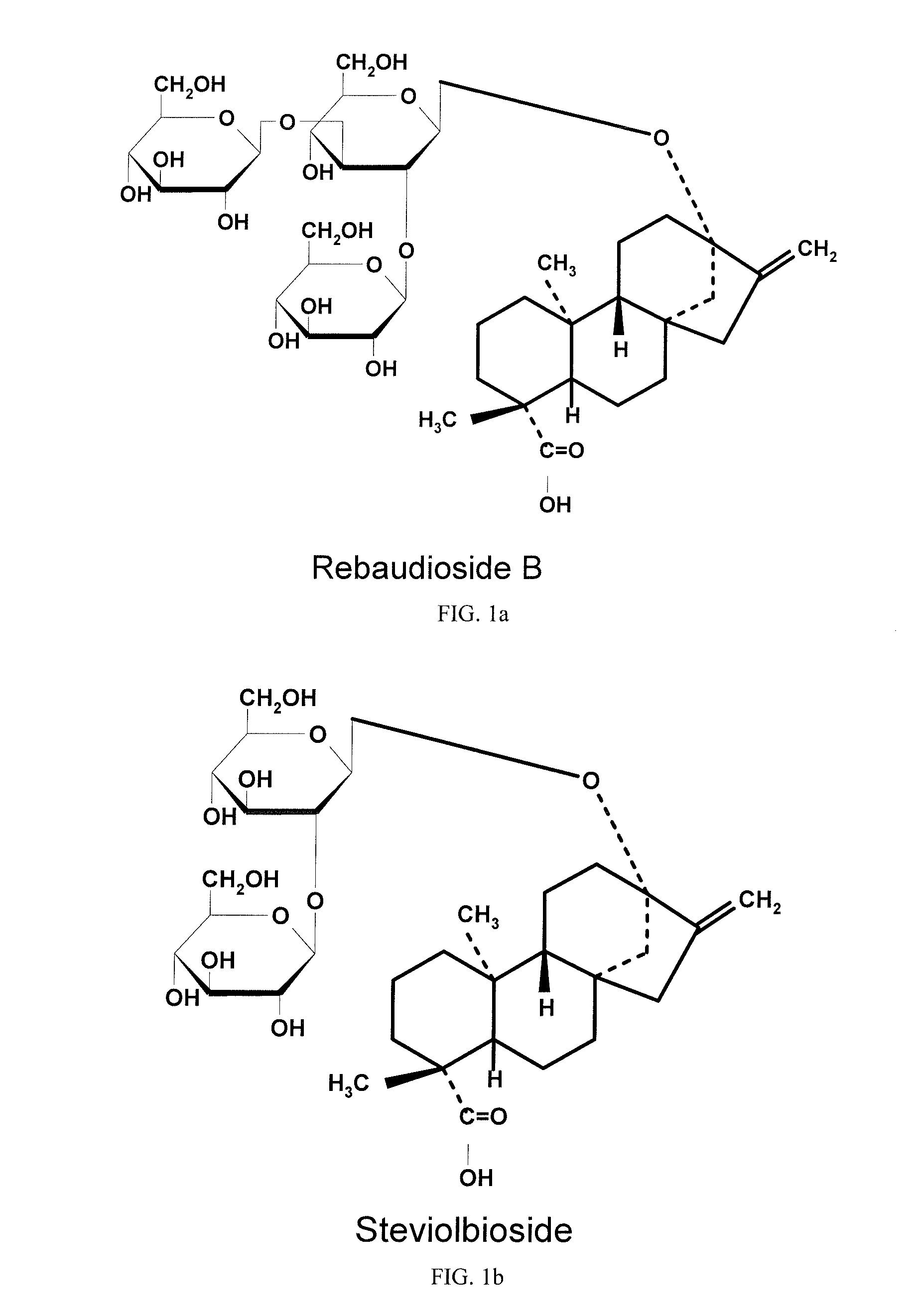Glucosyl stevia composition
a technology of stevia and composition, applied in the field of glucosyl stevia composition, can solve the problems of steviol glycosides still possessing undesirable taste attributes, commercialization of stevia sweeteners is this undesirable taste attribute, and the ban or restriction of sweeteners such as dulcin, sodium cyclamate and saccharin, etc., and achieves high purity
- Summary
- Abstract
- Description
- Claims
- Application Information
AI Technical Summary
Benefits of technology
Problems solved by technology
Method used
Image
Examples
example 1
Preparation of CGTase
[0059]A strain of Bacillus stearothermophilus St-88 was inoculated in 2,000 liters of sterilized culture medium containing 1.0% starch, 0.25% corn extract, 0.5% (NH4)2SO4, and 0.2% CaCO3 (pH 7.0-7.5) at 56° C. for 24 hrs with continuous aeration (2,000 L / min) and agitation (150 rpm). The obtained culture broth was filtered using Kerasep 0.1 μm ceramic membrane (Novasep, France) to separate the cells. The cell-free permeate was further concentrated 2-fold on Persep 10 kDa ultrafilters (Orelis, France). The activity of the enzyme was determined according to Hale, Rawlins (1951). A crude enzyme preparation with activity of about 2 unit / mL was obtained.
example 2
Preparation of Freely Soluble Reb B
[0060]1,000 g of reb B produced by PureCircle Sdn Bhd containing 97.1% reb B, 2.5% reb A, was suspended in 1,500 mL of water. The suspension was placed under agitator and heated to 80° C. 50% NaOH solution was added to the suspension till the pH reached 8.0. The suspension was agitated for 1 hr until complete dissolution. The obtained solution was dried using YC-015 laboratory spray drier (Shanghai Pilotech Instrument & Equipment Co. Ltd., China) operating at 175° C. inlet and 100° C. outlet temperature. 990 g amorphous powder was obtained with 40% (w / v) solubility in water (at 25° C.).
example 3
Preparation of Glucosyl Stevia Composition
[0061]100 g of tapioca starch was suspended in 300 mL of water (pH 6.5). 2 KNU of α-amylase (Termamyl Classic, Novozymes, Denmark) and 30 units of CGTase obtained according to EXAMPLE 1 were added, and the liquefaction of starch was carried out at 80° C. for about one hour to dextrose equivalent about 15. The pH of reaction mixture was adjusted to pH 2.8 by hydrochloric acid and the mixture was boiled at 100° C. during 5 minutes to inactivate the enzymes. After cooling to 65° C., the pH was adjusted to pH 6.0 with sodium hydroxide solution. 100 g freely soluble reb B obtained according to EXAMPLE 2 was added to liquefied starch and stirred until a homogeneous solution was obtained. 200 units of CGTase was added to the solution and the mixture was held at a temperature of 65° C. for 24 hours under continuous agitation. The obtained reaction mixture was heated at 95° C. for 15 minutes to inactivate the enzyme. After cooling to 65° C., 20 grams...
PUM
 Login to View More
Login to View More Abstract
Description
Claims
Application Information
 Login to View More
Login to View More - R&D
- Intellectual Property
- Life Sciences
- Materials
- Tech Scout
- Unparalleled Data Quality
- Higher Quality Content
- 60% Fewer Hallucinations
Browse by: Latest US Patents, China's latest patents, Technical Efficacy Thesaurus, Application Domain, Technology Topic, Popular Technical Reports.
© 2025 PatSnap. All rights reserved.Legal|Privacy policy|Modern Slavery Act Transparency Statement|Sitemap|About US| Contact US: help@patsnap.com



